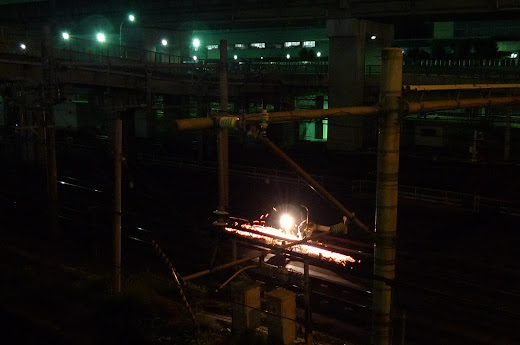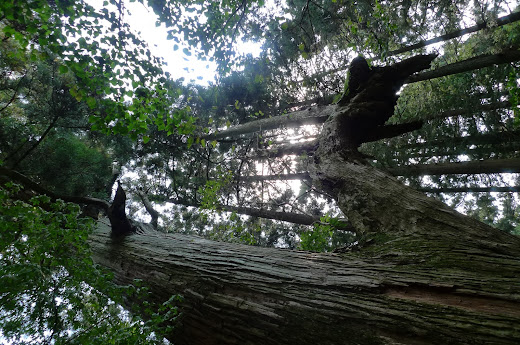Chelsea, my host in Tokyo, is accosted by inanimate bulls.
Bic Camera in Ginza, a multi-story electronics superstore with vastly overpriced wares.
Existence in Tokyo is a symbiosis with trains.
A train overpass in Kanda (神田), near the northwest corner of the Imperial Palace.
The evening commuter rush.
Commuter advertising, visible from the elevated train platform.
Outside Yūrakuchō (有楽町) Station. Pretty much every train station in eastern Tokyo has a surrounding neighborhood like this: bustling and crummy and crammed with off-work salarymen, with plenty of crappy cafes and beer-and-yakitori joints nearby.
More streets along the JR Yamanote line.
Late-night welding beneath the train tracks in Tabata (田端).
A boutique shopping street in Kichijōji (吉祥寺), about half an hour west of central Tokyo.
The entrance to a horror-themed bar in Kichijōji. With Halloween around the corner, this seemed like a fun place to be, but I also sorta wonder who actually goes to this place in like say mid-April.
"Shiro bukotsu" (武骨) ramen, with an intense, thick broth blackened with squid ink. This bowl came with four hefty slabs of fatty pork. And oh my god, the slabs of pork.
Chelsea has found an excellent escape from her fieldwork in food-porn blogging. This is a pretty nice deal for her short-term boarders, who get to sample her brilliant improvisations, such as this fried rice with bell peppers.
Another photogenic home-cooked meal. The noodles were handmade from chestnuts and flour.
A visit to a Thai restaurant near Yūrakuchō.
My Japanified Thai meal, consisting of pork belly, salted mustard greens with egg, and a fish curry.
I've come to believe that the chief distinguishing feature of Japanese cooking is a kind of studied and pleasant blandness, so it's a manifest curiosity to cross this sensibility with so emphatically florid a cuisine as Thai food. Incidentally, it ends up tasting a lot like the food I'd been eating in Shanghai a couple weeks before. Apparently both the geographic and culinary average of Thailand and Japan is China.
I celebrated a 5K run around the perimeter of the Imperial Palace grounds with a huge pile of fried pork cutlet. That the rice was served on a plate seemed highly non-Japanese, and yet totally appropriate to the meal.
About 50% of my caloric intake during my year with the JET Programme (2004-2005) consisted of the above snacks: lightly-salted potato chips (which I ate by the bag), the incredible Chococo cookie (certainly the greatest item in the entire Lotte catalog), and Pocky, which surely needs no introduction.
Self-portrait, at the main gate of Waseda University.
A view eastward from the edge of Waseda University.
A very strange and cool building along Sodai Dori, near Waseda University. The hair salon on the street corner had a full DJ station in the front window, but I was disappointed to find that nobody was actually manning the turntables; instead there was a stylist fidgeting with an iPod.
Next door was Guren (紅蓮), a tsukemen restaurant that we visited on the strength of a recommendation from Chelsea's ramen-crazed friend Nate. Tsukemen is like ramen, only with the broth and noodles served separately, which seems to provide the excuse to make both components much thicker and richer than they would be if combined.
In fact, Guren really only had one item, which was a shrimp-based tsukemen that could be ordered with varying quantities of wobbly, spring-like noodles. The broth was thick and briny, with a slightly bitter bite. I won't lie: it was pretty fucking incredible.
As with many noodle shops in big Japanese cities, the ordering process at Guren is mediated by a vending machine. You pick the amount of noodles you want, throw in some cash, punch a button, and you get a ticket. If you want a side, like a soft-boiled cured egg, you get another ticket for that specific purpose. Then you hand your ticket(s) to the server, who utters a few phatic pleasantries and then scurries off to the kitchen.
This is one of several procedures that one encounters in Japan that seem designed to obviate the need for any conversation between customer and server. Another example is the little placard at the checkout counter of my local supermarket--you place the placard in your shopping basket, and without further utterance, the cashier will refrain from handing you a plastic bag. Things like this are kind of fun at first, although it sort of dawns on you that they operate the principle that human interaction is somehow an impediment to convenience, or just basically somehow bad.
Outside a model gun shop, whose name I believe was actually "Model Gun Shop". Like any properly-civilized modern nation, Japan does not grant its citizens the right to bear arms. But said citizens sure do seem to fantasize about it.
Chelsea lives out in a sleepy east Tokyo neighborhood near the Sumida River, an area that would be classified as shitamachi (下町), or the "low" city. Historically, the shitamachi is associated with the working class and minority groups, namely ethnic Korean and Chinese, as well as the burakumin. It also evokes a hazy nostalgia for seedy streets and the quaint figures of the urban proletariat: salt-of-the-earth tradespeople, gregarious old folk, and prostitutes.
Here are some images from a walk along the river and through the neighborhood:
A view of Shinjuku, Tokyo's bureaucratic center, from a rooftop in Mejiro.
A festival procession held by members of the community in Mejiro, which felt a bit non-sequitor against the nondescript urban backdrop of the local JR statin.
To date, my sole excursion out of Tokyo was a hike up Mount Tsukuba (筑波山) in nearby Ibaraki Prefecture. This was billed as an "easy" hike by guidebooks, but was in reality comparable to a ninety-minute joyride on a Stairmaster machine. The trees were fantastic, but my enthusiasm for them was mitigated decisively by the vertical brutality of the terrain.
A stone "egg of the universe", supposedly a symbol of mu (無), or nothingness.
The reward for our hasty slog up the mountainside was a tasty bowl of Tsukuba udon, a local novelty dish that mysteriously sold for 900 yen at every single cafe on the summit.
Somewhere near Shinbashi, atop an elevated pedestrian concourse, I looked over and saw a--you know what, I really don't know what the hell this is.










































Yum. Cool. Wish I was there.
ReplyDeleteThanks for this. I enjoyed it.
ReplyDelete